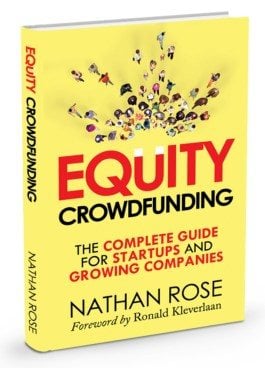
Nathan Rose is the Director of Assemble Advisory, an agency which specializes in helping businesses raise equity through crowdfunding. Originally from New Zealand, Nathan constantly crisscrosses the planet and speaks to entrepreneurs from around the world who have had success with equity crowdfunding. His insights have been captured in his book available on Amazon, “Equity Crowdfunding – The Complete Guide for Startups and Growing Companies”.
 I asked Nathan to share what he learned from observing equity crowdfunding in many different countries.
I asked Nathan to share what he learned from observing equity crowdfunding in many different countries.
Who are the entrepreneurs seeking to raise money through equity crowdfunding? Are they different from one country to the next?
For my book, I researched successful campaigns involving twenty startups who raised money on 12 different platforms in the US, Canada, the United Kingdom, France, Germany, Sweden, Finland, The Netherlands, Estonia, The Middle-East, Australia and New Zealand. I included quite a few case studies from Europe because equity crowdfunding is much more advanced there.
I discovered that the companies seeking to raise money through equity crowdfunding cover a much wider spectrum of industry sectors and business models than one would have expected.

At one end of the spectrum, you have innovative, capital hungry technology startups with high growth potential. An example is Pavegen, a UK company which produces flooring which generates electricity from the kinetic energy of people walking on tiles. Pavegen’s hot technology helped it raise nearly £2 million on a £750,000 goal on Crowdcube in 2015. At the other end of the spectrum, you have businesses operating in mature industries such as food, cosmetics or clothing. Companies such Haughton Honey, a Cheshire-based brand of raw honey, may seem less easily scalable, hence less attractive to a professional investor, but they are able through their products and values to engage retail investors. Haughton Honey raised £110,000 on an £80,000 goal in 2016, on Crowdcube as well.
Contrary to popular belief, B2B companies such as Pavegen can perform just as well as B2Ccompanies such as Haughton Honey. Although B2C companies may have more outreach potential with their natural consumer base, B2B can have an advantage in other areas, such as getting lead investors on board.
Why do startups turn to crowdfunding for funding?
For multiple reasons. Many of these companies want the promotion, not just money. MyCouchBox is a company that delivers snack packages. It raised €300,000 on German platform Companisto. The publicity impact for them was incredible. The crowdfunding campaign brought a lot of press coverage which significantly increased brand awareness.
Another motivation has to do with keeping control over the company, and remaining independent. Alicja Chlebna, from Sweden, is one such entrepreneur. She wanted to preserve the culture of her company, Naturalbox, a distributor of ethical, organic food, health and beauty products. She was also quite wary of becoming dependent on venture capitalists. She went to FundedByMe where she raised €212,160 and also found many kindred spirits among fellow entrepreneurs and investors from faraway places such as South-East Asia and the Americas.

Many businesses who turn to crowdfunding are businesses that fall outside of the VC grid. Glowee is a French startup which aims to exploit bioluminescence, the light emitted from for bacteria living in symbiosis with squids. When founder Sandra Rey tried to raise money from venture capitalists, these found it hard to place her business into a familiar category: biotechnology, energy… After a first successful rewards-based crowdfunding campaign on Ulule in 2015, Glowee raised more than €600,000 from 555 investors on WiSeed a year later.
In the same vein, ice cream is a business that may not seem scalable in the eyes of a venture capitalist. But crowdfunding platforms are more open to letting entrepreneurs take their chances.
This is what Charlie Thuillier did when he went to UK platform Seedrs with Oppo Ice Cream, a manufacturer of healthier ice cream with a slogan “indulge healthy”. The company has raised more than £1million in three fundraising campaigns, the last one via convertible notes. Oppo Ice Cream is a great example of a company which was able to bring its own crowd to the platform.
What makes equity crowdfunding campaigns successful? Did you observe differences across countries?
The recipe for success is quite consistent throughout the world.
The first success factor is the ability to dedicate the necessary resources to manage the campaign. All entrepreneurs agree that running a crowdfunding campaign is very demanding. One of them, Jasper Versteege of Winner Takes All had one failed offer on FundedByMe, after a successful one. He acknowledges that the second one failed because he couldn’t give it his full attention.
At Guusto, a digital card platform in Canada, one team member had to work full time on the campaign for two months, which is a big drain on resources for a startup. Yet, the company was genuinely enthusiastic about the new investors and the publicity brought about by the campaign.
Compliance-wise, things are easier in Northern European countries where regulation is more crowdfunding friendly than in countries where regulation puts a lot of strain on the startups and the platforms, like Canada and the US.
The second success factor is the ability to recruit the company’s own community to support the fundraising campaign. In this respect, some entrepreneurs questioned the value added by the platforms, especially by the smaller platforms. Entrepreneurs tended to be happier with the more established platforms who have a structure in place to advise them and bring a loyal audience of investors. Yet, even then, entrepreneurs recognize that they must deliver at least the initial batch of investors to start the ball rolling.

EkoRent from Finland, an electric vehicle rental startup, realized during their campaign on Invesdor that, unlike for their previous rewards-base campaign, social media marketing was not enough. They had to invest in many other outreach efforts to be able to raise €171,000.

Given these two success factors, it is clear that preparation is critical. The crowdfunding campaign does not start at launch but months ahead. The best example of excellence in preparation is the challenger bank Monzo. Monzo raised nearly £3.5 million from 9,000 investors in two campaigns on Crowdcube, one in March 2016 and one which recently ended on March 27, 2017. In each case Monzo recruited investors among clients and prospects well ahead of time, putting them on waiting lists, asking them to pledge money ahead of time. Both campaigns then reached their goals in record time.
What advice would you give to crowdfunding platforms so that they improve their services to entrepreneurs?
In general, entrepreneurs were more satisfied with platforms operating in the more established markets like the UK than with platforms operating in less established markets like the US and Canada. This points to the value of having a large and engaged Fintech community in which people know what crowdfunding is about because it has been around for 5 years. Thus my advice to platforms in the emerging markets is to be patient because it takes a few years for the market to take off.
 I also saw big differences in the degree of curation that takes place on platforms. Some platforms have the philosophy to open the gates and democratize access to fundraising while others want to present much more carefully selected businesses. This is a decision which each platform needs to make for itself. So long as they are clear about their philosophy, there appears to be room for both approaches. To US equity crowdfunding platforms, I would say that they are quite a few lessons to be learned from what is being done in Europe.
I also saw big differences in the degree of curation that takes place on platforms. Some platforms have the philosophy to open the gates and democratize access to fundraising while others want to present much more carefully selected businesses. This is a decision which each platform needs to make for itself. So long as they are clear about their philosophy, there appears to be room for both approaches. To US equity crowdfunding platforms, I would say that they are quite a few lessons to be learned from what is being done in Europe.
 Therese Torris, PhD, is a Senior Contributing Editor to Crowdfund Insider. She is an entrepreneur and consultant in eFinance and eCommerce based in Paris. She has covered crowdfunding and P2P lending since the early days when Zopa was created in the United Kingdom. She was a director of research and consulting at Gartner Group Europe, Senior VP at Forrester Research and Content VP at Twenga. She publishes a French personal finance blog, Le Blog Finance Pratique.
Therese Torris, PhD, is a Senior Contributing Editor to Crowdfund Insider. She is an entrepreneur and consultant in eFinance and eCommerce based in Paris. She has covered crowdfunding and P2P lending since the early days when Zopa was created in the United Kingdom. She was a director of research and consulting at Gartner Group Europe, Senior VP at Forrester Research and Content VP at Twenga. She publishes a French personal finance blog, Le Blog Finance Pratique.

